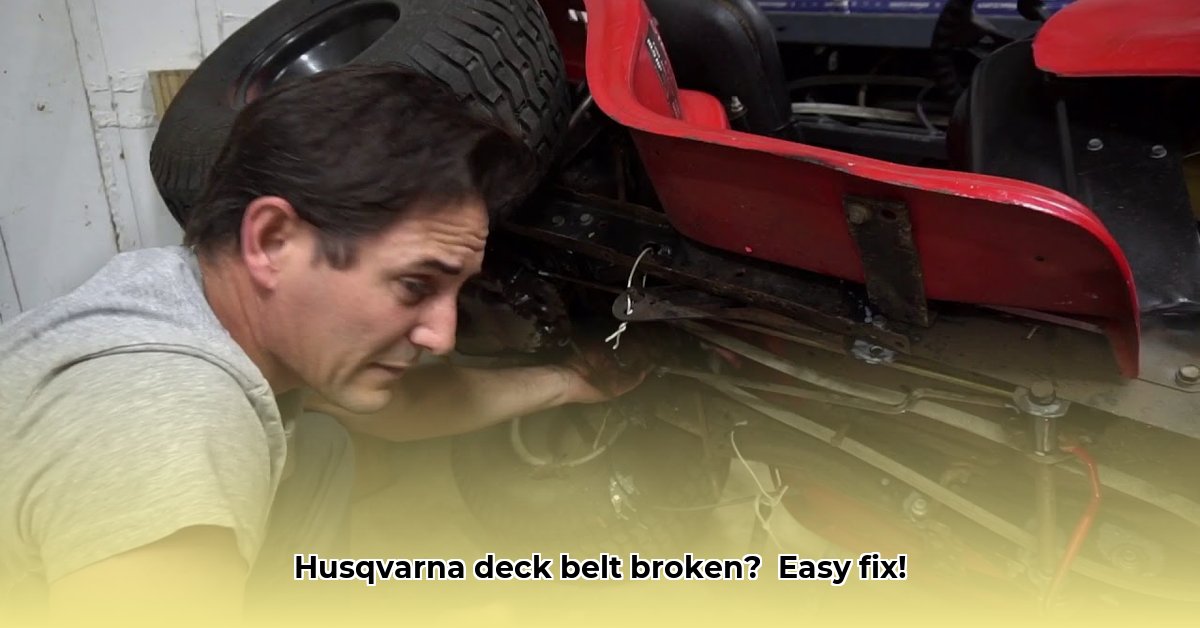
Replacing Your Husqvarna Lawn Tractor Deck Belt: A Comprehensive Guide
Replacing your Husqvarna lawn tractor's deck belt is a common maintenance task that many homeowners can tackle themselves. However, the specific procedure varies significantly depending on your model. This guide provides model-specific instructions and general troubleshooting advice to help you get the job done safely and efficiently. Remember, your owner's manual is the ultimate reference for your specific tractor. For additional resources on lawn tractor maintenance, see this helpful guide.
Key Takeaways:
- This guide provides step-by-step instructions with visual aids for replacing your Husqvarna lawn tractor's deck belt.
- Specific procedures vary widely among Husqvarna models, necessitating model-specific instructions.
- Preventative maintenance, including regular belt inspections, is crucial for maximizing equipment lifespan.
Safety First!
Before you begin ANY work on your tractor:
- Disconnect the spark plug wire: This is absolutely critical to prevent accidental starts.
- Engage the parking brake: This prevents the tractor from rolling unexpectedly.
- Lower the cutting deck completely: This minimizes the risk of injury from moving parts.
- Wear safety glasses: Protect your eyes from debris.
- Wear work gloves: Protect your hands from cuts and grease.
Tools You'll Need (May vary by model)
The exact tools will depend on your specific Husqvarna model, but generally, you'll need:
- Socket wrench set (various sizes)
- Wrenches (various sizes)
- Screwdrivers (Phillips and flathead)
- Pliers (needle-nose and regular)
- New deck belt (Ensure it's the correct part number for your model; check your owner's manual)
- Wire brush (for cleaning pulleys)
General Steps for Replacing a Husqvarna Deck Belt
While the exact steps vary by model, these general steps apply to most Husqvarna lawn tractors. Refer to the model-specific sections below for detailed instructions.
- Prepare the Area: Clear any debris (grass, leaves, etc.) from around the mower deck.
- Locate the Belt: Identify the belt's path. Taking photos before removal is highly recommended.
- Release Belt Tension: Most models have a tensioner pulley or lever; release it to ease belt removal.
- Remove the Old Belt: Carefully remove the belt from the pulleys.
- Inspect Pulleys: Check pulleys for wear; replace damaged parts.
- Install the New Belt: Route the new belt precisely as the old one was routed (refer to your photos!).
- Re-tension the Belt: Re-engage the tensioner to achieve proper belt tension (see owner's manual for specifics).
- Test Run: Briefly start the engine and check for smooth blade rotation.
- Reassemble: Replace any panels or covers removed during the process.
Model-Specific Instructions (To be added)
Detailed, illustrated instructions for specific Husqvarna models will be added in future updates. Check back soon for guides on popular models such as the TC112, TS138L, and others. Each section will include high-resolution images and diagrams specific to that model.
Remember to consult your owner's manual for your specific model's detailed diagrams and instructions. These model-specific sections will become available as they are verified. This will include detailed diagrams and numerous high-resolution photographs of the process for each particular model.
Troubleshooting Common Issues
Belt Slipping: Ensure the belt is correctly seated within all pulleys. Improper tension is a common culprit. Check your owner's manual for proper tension adjustment. Worn or damaged pulleys can also cause slipping and should be replaced. A worn tensioner spring should also be replaced.
Belt Breaking: This generally points to a more significant problem, such as a seized pulley or other mechanical issue. A broken belt may also indicate the need for lubrication of moving parts. Further investigation or professional service might be necessary.
Preventative Maintenance: Extending the Life of Your Deck Belt
Regular inspections and maintenance are crucial for extending the life of your Husqvarna lawn tractor's deck belt and preventing unexpected breakdowns. Inspect your belt at the start of each mowing season. Look for signs of wear, such as cracks, fraying, or glazing. Replacing a worn belt before it breaks prevents more significant damage. Clean the pulleys regularly to minimize wear.
By following these steps and consulting your owner’s manual, you’ll be able to keep your Husqvarna lawn tractor running smoothly and efficiently which will save you time and money in the long run. Remember that a little preventative maintenance goes a long way!